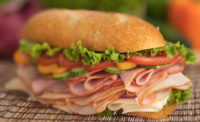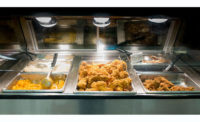While having a wide array of attractive selections is essential if deli operators are to boost or maintain meat and poultry sales, just offering such options is not enough. Merchandisers must also effectively spotlight the options to consumers if the sector is to thrive, analysts say.
“It's all about communication and ensuring consumers can easily find either the products they are looking for or discover new items,” says Maeve Webster, president of Menu Matters, an Arlington, Vt.-based food industry consulting firm. She notes that retailers also must “think a bit like online shopping sites” by determining how they can get current customers to discover and sample new products.
While there are immense growth opportunities from expanding, upgrading and revising all varieties of deli meat and poultry, it is crucial that operators successfully market the offerings to shoppers if they are to incite interest and purchasing, says Jim Wisner, president of Wisner Marketing, a Gurnee, Ill.-based market research, education and consumer packaged goods consulting firm.
“The more informed you get the customer, the more things they will try,” he notes. “You can do 90 percent of it with signage.”
Other effective marketing vehicles for deli meats and poultry include websites, social media channels, text messages to consumers that are already in stores and cross-department merchandising that, for instance, may highlight the use of fresh bread from the bakery on deli sandwiches, says Eric Richard, industry relations coordinator for the Madison, Wis.-based International Dairy Deli Bakery Association (IDDBA).
“Smell, sight and taste will draw people to the deli,” he notes.
In addition, operators should consider such promotions as buy one sandwich and get 50 percent off the second; dollar-off deals; and bundled meal offers to help drive initial interest and build a bigger basket, says Tom Super, senior vice president of the Washington, D.C.-based National Chicken Council.
Limited time only offers also are effective, says Russell Zwanka, associate professor, food marketing, in the Department of Marketing at Western Michigan University in Kalamazoo. He notes that customers “love to buy something before someone else can get it.”
Attaching quick response (QR) codes or similar symbols on packages that enable shoppers to learn more about the product’s attributes by scanning the symbols with their smart phone cameras also will boost business, Super says.
Zwanka adds that because food trends start in restaurants and on social media, it is important for deli operators to review postings on Pinterest, Facebook, Instagram and other online channels in order to launch attractive and relevant offerings. “Make sure you have an avid foodie watching for trends, then address them quicker than your competition,” he states.
Put the spotlight on sustainability
Such trends include the increasing consumer interest in sustainability. Webster notes that it is vital for deli operators to communicate their eco-friendly methods clearly and thoroughly.
That may include spotlighting the packaging that uses biodegradable materials that are acceptable for recycling and the containers that have less material, Super says.
“Shoppers are seeking packaging that is not harmful to the earth and the environment, and more deli packaging will gravitate to that,” Richard says. He concurs that it is important for deli operators to highlight the sustainable attributes on packaging. “That can include noting that the package is 100-percent recyclable, or the product was developed in an environmentally friendly manner,” he says.In-store sampling is another effective merchandising vehicle which can alert shoppers to product availability and prompt them to trade-up to more value-added items, Wisner says. “Encouraging people to do a trade-up always works well,” he notes.





Report Abusive Comment